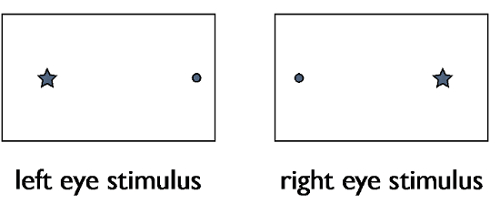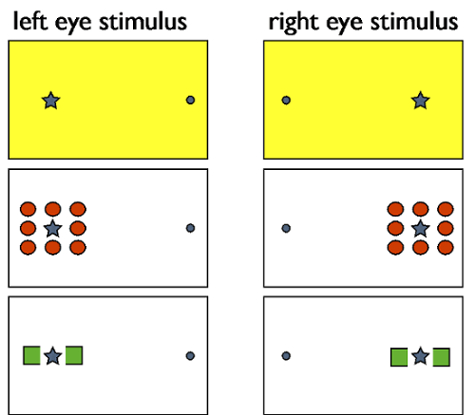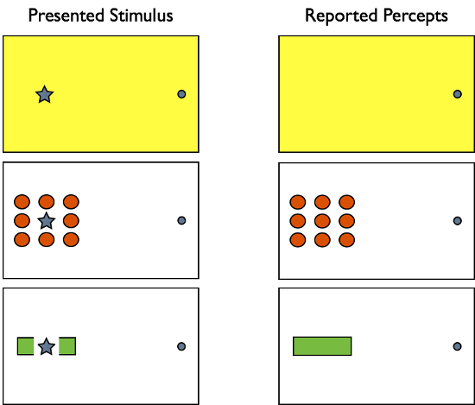Finding Your Blind Spot and Perceptual Filling-in
Overview
Source: Laboratory of Jonathan Flombaum—Johns Hopkins University
In the back of everyone's eye is a small piece of neural tissue called the retina. The retina has photosensitive cells that respond to stimulation by light. The responses of these cells are sent into the brain through the optic nerve, a bundle of neural fibers. In each retina there is a place somewhere in the periphery where the outputs from retinal cells collect and the bundled optic nerve exits to the brain. At that location, there is no photosensitivity-whatever light reflects from the world and lands in that position does not produce a signal in the brain. As a result, humans have a blind spot, a place in the visual field for which they don't process incoming stimuli.
However, people are not aware that they have blind spots; there is not an empty hole in the visual images in front of the eyes. So what do people see in their blind spots? The brain actually fills-in missing input based on the surroundings.
This video demonstrates how to find a person's blind spot, and how to investigate the mechanisms of perceptual filling-in.
Procedure
1. Stimulus Design
- Open a blank white page in a slide editor (PowerPoint or Keynote will suffice).
- Near the right edge of the page, make a circle about as large as penny, when the slide is printed. This will be the fixation point.
- Near the left edge of the page, make a small star (or any other shape), so that when you print the slide, the shape is about the size of a penny This slide is the left eye blind spot stimulus.
- Duplicate the slide, and switch the positions of the fixation point and the shape. This makes the right eye stimulus.
- Print the stimuli.
- Figure 1 shows what these stimuli should look like when printed on an 8.5 x 11 piece of standard white paper.

Figure 1. Stimuli for finding the blind spot in each eye. The stimuli should each occupy an 8.5 x 11 in. piece of paper with the star about the same size as a penny, when printed.
2. Procedure for finding the blind spot
- Explain the procedure first for the left eye, then how to adjust it for the right eye. This procedure can be performed on one's self, or recited to an observer to perform.
- Hold the left eye stimulus sheet at arm's length with the shapes facing you.
- Now close or patch your right eye. With your left eye, fixate the circle on the right side of the page. You will still probably see the star on the other side.
- Slowly move the page to the left or to the right, up or down, closer and farther. At some point, the star will disappear from the corner of your eye.
- Once you have made the star disappear, move the page around in very small increments. You should be able to make the star appear and re-appear through small adjustments.
- The place where the star is when you cannot see it is your blind spot.
- Repeat the procedure with the right eye stimulus, closing your left eye this time.
3. Using the blind spot to study perceptual filling-in
- With slightly more complicated stimuli, the blind spot provides a powerful demonstration of how the brain creates, even at times invents, our perceptual consciousness.
- Generate three additional blind spot stimuli by placing the star shape among some kind of pattern-this can be as simple as a colorful background or within a continuous line segment. Figure 2 shows three example stimuli.
- Repeat the procedure in 2.2-2.7. This time though, ask the participant what they see when the star stimulus disappears.

Figure 2. Blind spot stimuli for demonstrating properties of perceptual filling-in. In these images, when the star occupies an observer's blind spot, their brains fill-in the missing stimulation to conform to the properties of the surrounding image.
Results

Figure 3. Perceptual reports: What participants report seeing (shown in the right column) when the star in the left column images disappears in the blind spot. The reports reveal several principles of how the brain creates perceptual experience. Most broadly, in all cases, the brain fills-in the blind spot as the most likely content given the local context.
Figure 3 visualizes what people report seeing when shown the stimuli in Figure 2, that is, what they report seeing once the star disappears because it occupies their blind spot.
The reports revealed several principles of how the brain creates perceptual experience. The top stimulus revealed that the brain tends to expect uniformity in surface color, thus filling-in the blind spot to match the yellow background in the remainder of the image. The middle stimulus revealed that the brain looks for patterns, here causing perceptual experience to include a red circle in the blind spot in order to complete the prevailing pattern in the region. The bottom stimulus revealed that the brain implements expectations about object continuity. When the star occupies the blind spot, observers see a solid green rectangle, filling-in the missing middle portions of that object. Thus in general, the brain fills-in experience with the most likely stimulus to occupy the blind spot. Whatever is most likely given the context is what the brain causes people to perceive.
Application and Summary
Because the brain fills-in perception within the blind spot, one application involves studies that seek to identify the brain areas involved in producing conscious experience. For example, for a long time, researchers were uncertain whether the earliest part of human visual cortex, called V1, was involved directly in the production of conscious experience. To address this issue, researchers used fMRI (Functional Magnetic Resonance Imaging) to measure neural responses in the monocular regions of V1 that mapped to the blind spot.1 In other words, they looked at neural regions that only received input from one of the eyes, and by mapping the blind spots of their participants, they were able to look at neural responses specifically when direct stimulation was absent, because the stimulus was placed in the relevant eye's blind spot. What should happen? Would the neurons not fire because they were not receiving any signal from the outside world? Instead the neurons responded as though they were being stimulated by what the person perceived in that location-they responded as though the images that the brain filled-in were actually producing external stimulation. This suggested that these neurons in very early parts of the visual system are not only involved in transmitting signals received from the retina, but also in constructing perceptual experience itself.
References
- Tong, F., & Engel, S. A. (2001). Interocular rivalry revealed in the human cortical blind-spot representation. Nature, 411(6834), 195-199.
Skip to...
Videos from this collection:

Now Playing
Finding Your Blind Spot and Perceptual Filling-in
Sensation and Perception
17.3K Views

Color Afterimages
Sensation and Perception
11.1K Views

Perspectives on Sensation and Perception
Sensation and Perception
11.8K Views

Motion-induced Blindness
Sensation and Perception
6.9K Views

The Rubber Hand Illusion
Sensation and Perception
18.3K Views

The Ames Room
Sensation and Perception
17.4K Views

Inattentional Blindness
Sensation and Perception
13.2K Views

Spatial Cueing
Sensation and Perception
14.9K Views

The Attentional Blink
Sensation and Perception
15.8K Views

Crowding
Sensation and Perception
5.7K Views

The Inverted-face Effect
Sensation and Perception
15.5K Views

The McGurk Effect
Sensation and Perception
16.0K Views

Just-noticeable Differences
Sensation and Perception
15.3K Views

The Staircase Procedure for Finding a Perceptual Threshold
Sensation and Perception
24.3K Views

Object Substitution Masking
Sensation and Perception
6.4K Views
Copyright © 2025 MyJoVE Corporation. All rights reserved